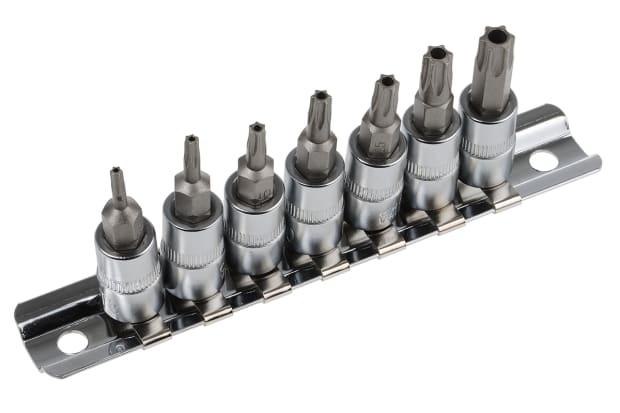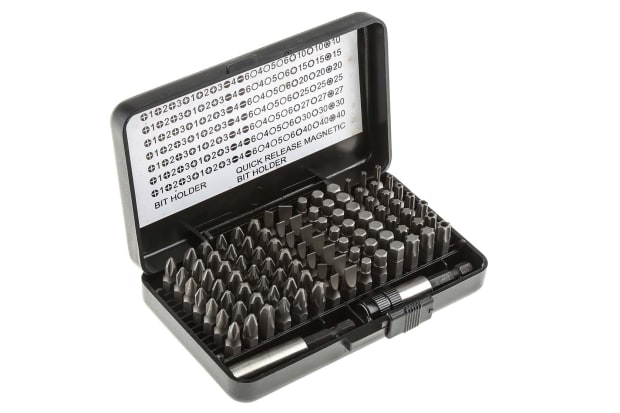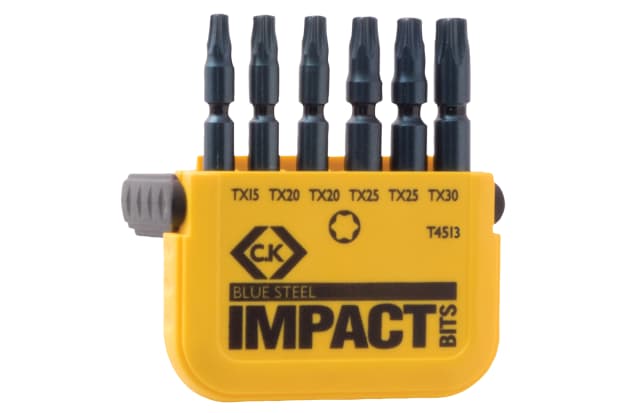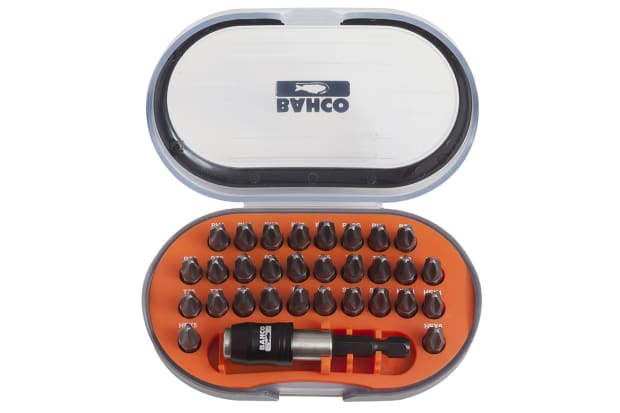- Published 24 Apr 2024
- Last Modified 24 Apr 2024
- 9 min
The Complete Guide to Screwdriver Bit Sets

What are screwdriver bits and bit sets?

An extremely familiar component in nearly all toolboxes and carry kits, screwdriver bits are the detachable and interchangeable slim metal components designed to be fitted into the chuck end of screwdrivers.
Manufactured explicitly for the purpose of driving and extracting screws, many modern screwdriver bit sets feature dozens of different bit shapes and sizes, attachments and accessories. Collectively, they’ll help everyone from novice users to seasoned pros tackle a very wide range of screw head types, and cover you in an incredibly varied range of tasks and applications.

When the process of inserting a bit and driving a screw is carried out correctly, the convenience of screwdriver bit sets offer a remarkably simple and efficient method of mating two surfaces together sturdily and reliably. With just a few simple caretaking steps observed, the same basic driving techniques will see you through any number of assembly, maintenance and construction tasks quickly and with minimal physical strain.
However, there certainly is a technique involved when it comes to driving screws properly - and, above all, the key to success lies in selecting the right screwdriver bit for the fastener type. Failing to do so can easily result in split timbers, ruined work surfaces, sheared or stripped screws, irregular hole shapes, damage to tools, and even user injury in the worst case scenario.

To help avoid this, a hugely diverse range of screwdriver bits and screwdriver bit sets is sold by suppliers and manufacturers worldwide, often designed to accommodate a myriad of different screw shapes and sizes. The ideal bit choice for any given project will depend chiefly on the specific screw type and size being used, as well as - to a lesser extent - the sort of surface you’re driving it into.
In this guide, we’ll explore some of the more common types of screwdriver bits you’ll find in kits sold by most dedicated stockists and wholesalers around the world, and offer some pointers on the relative pros and cons of each for particular applications.
We’ll also cover some of the more renowned brands and manufacturers of screwdriver bits and accessories available on today’s market, to give you an overview of trusted names you might like to look out for when it’s time to buy or upgrade your next screwdriver bit set.
How do screwdriver bits work?

Both in the UK and internationally, the majority of screwdriver bit sets sold to professionals and hobbyists alike are typically manufactured for use in a compatible handheld cordless power tool. The tool in question may either be a dedicated cordless screwdriver, or a multi-purpose drill driver.
After securing the bit in the chuck of your chosen driver, the tip is then inserted into the drive head of an appropriately fitting screw. Once the bit is inserted into a screw head, the torque or rotation force provided by the screwdriver motor is transferred directly through the bit attachment into the screw itself, driving it into your workpiece.
As noted in the introduction to this guide, different sorts of screwdriver bits are designed for different screw heads and sizes, and will often vary considerably in their precise configurations and features. However, more or less all screwdriver bits have a few basic elements in common - these include:
Bit shank
- This is the part designed to slot into the screwdriver or drill driver chuck, which is then tightened around the shank ready for driving
- The shank is almost always hexagonal in cross section, making them suitable for use in almost all correctly sized driver chucks (including 3-jawed, 4-jawed, magnetic and quick release types)
Bit tip
- This is the ‘pointed’ end (different designs will have varying degrees of pitch at the tip, but nearly all are tapered to some extent) that engages directly with the recess in the head of the screw
- It’s the most diverse aspect of most screwdriver bit sets, and making sure you choose the correctly sized and shaped bit for the fastener you’re driving is important
- Screwdriver bit tips may be coated or hardened, and are frequently magnetic to allow for easier engagement with and retention of most metal screws
Common user errors and problems with screwdriver bits
The two most common complaints users tend to experience when using screwdriver bit sets are slipping or ‘camming out’, and stripping/damaging a screw head (or, less frequently, the bit itself).
The latter is most often caused by using the wrong size or type of screwdriver bit for the screw, although excessive wear to either part can also be a direct cause. Either way, the likelihood of either problem occurring is dramatically reduced by ensuring you select the right bit for the job at hand.
‘Camming out’ is the technical term for when a screwdriver bit slips out of the recessed slot in the head of a screw. It’s a fairly common issue when the torque of the driver tool suddenly exceeds the bit’s grip in the screw head, and if you’re unlucky enough it can easily result in damage to adjacent surfaces.
Although cam-out is generally seen as an undesirable outcome, some types of screw heads and screwdriver bits were in fact designed specifically to allow for it. The extremely popular Phillips head (cross or cruciform) shape is the most notable example - the original intent was to help avoid damaging workpieces through excessive torque or ‘overdriving.' Various other sorts of screw heads and screwdriver bits are explicitly manufactured to prevent cam-out, including both Pozidriv and Torx alternatives.
What types of screwdriver bits sets are there?

As we’ve already seen, there are many different sorts of screwdriver bits and screwdriver bit sets available on today’s market. The most popular and widely available sets generally include anything from half a dozen to 100 or more individual pieces, with the more expensive kits tending to include the larger and more diverse array of attachments and accessories.
Although the included range of bit shapes and intended uses is often vast in high-end kits, the bulk of all screwdriver bits can be sorted into one of two broad categories - namely insert bits and power bits. Insert bits tend to be more common, cheaper, and smaller; power bits tend to start at around 2” in length and are usually sturdier, more expensive and more resistant to rapid wear under more demanding conditions.
Regardless of the specific tip type or shape in question, typical materials used for components frequently found in all but the most basic screwdriver bit sets might include:
Alloy steel-tipped screwdriver bits
- For general DIY and lighter construction purposes
- Most ‘standard’ screwdriver bits are made from steel
Extra long screwdriver bits
- For addressing specific access issues on jobs in inconvenient or cramped spaces
- In general, shorter screwdriver bits are preferred for transferring greater torque
- Long bits are more prone to camming out, stalling or twisting under higher torque
Diamond-tipped screwdriver bits
- For more heavy duty jobs where increased friction and torque is required
- Titanium tips or titanium coatings are also a fairly frequent option
Impact screwdriver bits
- For the heaviest duty driving into more solid or dense materials
- These are intended specifically for use with impact drivers to provide maximum torque, and are thus made from correspondingly tougher materials
Phillips screwdriver bits and sets
Phillips screwdriver bits are among the most widely used of all types today. There are probably still more slotted or ‘flathead’ screws and screwdriver bits in overall circulation, but those are often a result of older standards not being updated and are largely seen as something of a legacy design by modern standards.
Philips screwdriver bit sets are immediately identifiable thanks to their familiar cross-shaped tip, designed to fit into the equally popular range of multi-purpose cruciform screws and fasteners. Initially developed during the 1930s for use in the American auto sector, they’re often abbreviated to PH bits, and the majority are sold today in sizes ranging from 0 to 3 to fit the corresponding screw head sizes.
A design feature - or flaw, depending on how you look at it - of Phillips head screws and bits is that they allow for relatively easy camming out above a certain torque threshold.
Slotted screwdriver bits and sets
As noted in the section on Phillips driver bits above, slotted screws and screwdriver bit sets are still widely encountered out in the field these days, although that’s largely as a result of them having once been the go-to format for nearly all screwdriving applications.
In practice, slotted screwdriver bits seldom feature especially prominently in modern screwdriver bit sets intended for use with power tools, as their simplistic design makes slipping off and damaging the screw head far too easy for comfort under even moderate torque conditions. That said, most screwdriver bit sets will always include at least one or two pieces built to tackle various sizes of slotted fastener, which remain a common format among smaller-gauge countersunk screws (particularly brass).
Pozidriv screwdriver bits and sets
Pozidriv screwdriver bit sets are often abbreviated to ‘Pozi’ or PZ and were initially conceived as a development of the basic principles that made Phillips head bits so successful. They essentially copy the basic cross shape of the Phillips drive, but with the addition of an additional cruciform groove overlaid at a 45 degree angle to the main one.
This gives the Pozi bit more points of contact with the screw head, and thus allows for application of higher torque with less risk of cam-out. The trade-off is that the individual driver blades themselves are thinner, and so more prone to damage or shearing under heavy use.
The heads of PZ screws are less deeply recessed than Phillips versions, which means the corresponding Pozidriv screwdriver bits are less sharply tapered. With an appropriate amount of torque, rotation speed and pressure applied, they’re generally seen as easier to control while driving than many other bit types.
Torx screwdriver bits and sets
Torx screwdriver bits are generally seen as a functionally similar yet differently designed alternative to Pozi bits, and Torx versions are notable for the pronounced star or asterisk shape of their driver tips and screw head recesses.
Again, they’re primarily designed to allow for much higher torque without camming out, as there are more points of direct and stable contact being made between the Torx bit and the recessed screw head at any given moment. One possible disadvantage of this is that it’s easy to overdrive a screw using the Torx system, particularly into softwoods and other less dense materials.
Square head screwdriver bits and sets
Square head screwdriver bits, also known as Robertson bits after their Canadian inventor, were once very common. They were widely used around the same time as slotted heads, due largely to their cost-effective and simple manufacturing process.
Again though, they’re less likely to feature prominently in most modern screwdriver bit sets, as they’re rapidly being replaced by the more versatile hex bits and socket screw combinations, which are easier to work with and equally effective at preventing cam-out.